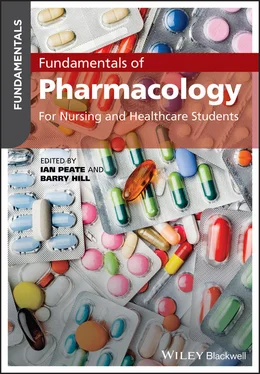Virtue ethics focuses on how we ought to behave, and how we should think about relationships, rather than providing rules or formulas for ethical decision‐making. It considers the virtues a ‘good’ person would have: honesty, compassion, generosity and courage, for example (Velasquez et al., 2009). With the common good in mind, these virtues will be applied to actions and decisions. A group of virtues can be accredited to particular roles or professions, and it could be argued that nurses are attracted to the profession because they already function according to these virtues.
This leads us to nurse ethics. The focus of nursing ethics is on developing a caring relationship and seeking a collaborative relationship with the person. Recently, care, compassion, courage, communication, commitment and competence (the 6 Cs Department of Health, 2012) have been highlighted as the required virtues of nurses. Common themes of nursing ethics emphasise respect for the autonomy of the individual and maintaining the dignity of the client by promoting choice and control over their environment.
What is deemed to be right is not therefore bound by absolute rules or duty, or purely the greatest good, but also considers the virtues that individuals and society value. The ethical views held by society affect healthcare laws and how they are implemented. As society's moral values alter, legislation follows. An example of this was in 1967 when UK society's beliefs changed regarding abortions. It became largely accepted that in some cases they were necessary for saving women's lives as well as reducing the potential for suffering (psychologically as well as physically) of the woman and her pre‐existing family, and so the Act was introduced (Abortion Act, 1967).
In order to practice, healthcare professionals are aligned to a regulatory body such as the Nursing and Midwifery Council (NMC) or the Health and Care Professions Council (HCPC). The purpose of a regulatory body is primarily to protect the public, and as such they are established and based upon a legal mandate. Their function is regulatory and to impose requirements, restrictions and conditions – as well as offering a means of support and guidance to professionals. They also set standards in relation to practice activities, securing compliance and enforcement of their practitioners. Regulatory bodies have traditionally provided their practitioners with ethical guidance in the form of a ‘code’ or an ‘oath’, such as the NMC Code of Conduct (2008) or the Hippocratic Oath for doctors. A word of caution though; codes such as the NMC Code of Conduct (2008) could be viewed as merely being concerned with specifying rules of responsibility and conduct rather than focusing specifically on ethics.
Within healthcare, regulatory bodies have a duty to protect, promote and maintain the health and safety of the public. They do this by ensuring proper standards are in place in order to practice. Such standards define the overarching goals and the expected role and duties of their practitioners through listing the obligations associated with their individual responsibilities and skill set. The overarching goals are aspirational and represent an optimal position ethically, thus encouraging the individual to strive towards the optimal position. Healthcare professionals, like the public and their patients, possess their own values and beliefs which in turn influence their practice.
Imagine yourself working in a very busy gynaecological outpatients and you are required to administer mifepristone (medically induced abortion) to a young intravenous drug user (IVDU), currently sofa surfing among friends. Your service user is advised to return in between 24 and 48 hours for the second medication – misoprostol, to complete the treatment. She does not return. You notice certain client groups tend not to return to the clinic and you begin to think about why this is the case, using the principles of ethical professional practice, beneficence (do good) and non‐maleficence (do no harm).
Within this scenario, there is a possibility the service user's care has been affected by the healthcare professionals implicit bias (IB) towards certain social groups. Several authors have emphasised that a well‐meaning, egalitarian (fair) minded individual can have implicit biases which demonstrate the imbalance between their unconscious ways of thinking and how they explicitly perceive themselves treating people (Fitzgerald and Hurst, 2018; Lang et al., 2016). The elements of IB are one's perceived stereotypes (a mental picture of what one thinks, knows and expects) and prejudices (feelings) associated with certain categories of people, learnt through a shared culture, which over time slips into one's unconsciousness, which means it is hidden (Lang et al., 2016). As Stone and Moskowitz (2011) explained, this means the healthcare professionals are unaware of their biases, which impacts on the quality of care delivered, seen in how they may judge and behave towards particular groups (Kelly and Roedderts, 2008). Merino et al. (2018) highlighted over 60% of healthcare professionals harbour variants of IB towards marginalised/vulnerable groups. Examples of vulnerable or marginalised groupings can be based on: gender, age weight, homelessness, ethnicity, immigration status, socio‐economic status, educational achievement, mental ill‐health, sexual orientation, IVDUs, disabilities and social circumstances – or anyone rendered vulnerable in certain situations (Fitzgerald and Hurst, 2018).
There is a consensus that stereotyping saves cognitive resources in stressful environments, a situation healthcare professionals often find themselves in (Hall, 2017). Drawing on these stereotypes enables the healthcare professional to make timely decisions based on the minimal information available in times of fatigue, tiredness, heavy workload, uncertainty and inadequate support (Stone and Moskowitz, 2011). Nonetheless, it remains that there is a clear link between IB and the quality of care delivered and how it potentially influences the healthcare professionals ability to engage in person‐centred care (Merino et al., 2018). Fitzgerald and Hurst (2018) stated that a healthcare professionals IB behaviour towards marginalised groups can impact on the service user's access to healthcare service by producing false diagnoses, non‐referral to appropriate services, limiting treatment options or withholding of treatment. Goyal et al. (2015) detailed how IB may have contributed to the creation of health disparities, as African‐American children were less likely to receive adequate pain management post‐appendectomy than their white counterparts. IB influences within clinical interactions can leave the service user feeling uncomfortable as they pay attention to the healthcare professionals non‐verbal mannerisms, such as eye contact, physical closeness and speech errors which can demonstrate the healthcare professionals dislike or unease of dealing with particular clientele (Stone and Moskowitz, 2011). This in turn may not only impede patient–healthcare professional communication, but may also affect patient concordance and willingness to seek future care.
Puddifoot (2017) highlighted that IB can cause an ethical dilemma, demonstrated earlier, as there is potential to do harm within these client groups through the healthcare professionals judgment and behaviour based on their IB. Positive beneficence requires the healthcare professional to consider benefits for others alongside balancing the risks (Baillie and Black, 2015), which is compromised through the harbouring of IB. Such behaviours are in direct contradiction of the professional regulatory bodies' codes of professional performance; therefore, the healthcare professional should reflect upon how they interact with certain client groups to develop awareness of any implicit biases they may have (Lang et al., 2016). Additionally, Stone and Moskowitz (2011) recommend learning courses to expand the healthcare professionals cultural competence by learning about IB.
Читать дальше












